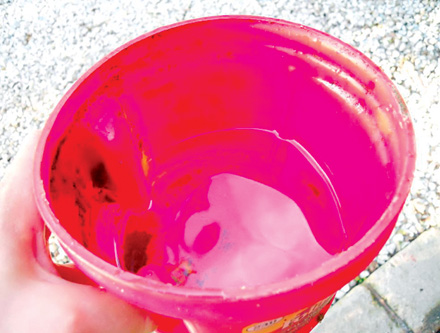They’re back

I was just about to pick a few lovely pink Rose of Sharon flowers when I saw them inside the double blooms. Japanese beetles.
Yep, they’re here, a few weeks earlier than usual according to University of Missouri Extension Service. For the next six weeks or so, it will be a battle between these wily bugs and me. A beautiful iridescent green, the 3/8th of an inch non-native insects are eating machines, devouring fruit trees, roses and anything else edible in a garden.
According to several experts, the Japanese beetle is probably the most devastating pest of urban landscape plants in the eastern United States. Japanese beetles were first found in this country in 1916 after accidentally being introduced into New Jersey. Until that time, this insect was known to occur only in Japan where it is not a major pest.
The eastern US provided a favorable climate, large areas of turf and pasture grass for developing grubs, hundreds of species of plants on which adults could feed, and no effective natural enemies. Conditions remain pretty much the same today.
Once they turn from grubs into beetles, Japanese beetles set off a scent that says “let’s party” to other Japanese beetles. Don’t fall for the traps, those are pheromone-laced invitations bringing more beetles close unless you hang them down wind at the end of your property – and don’t particularly like your neighbors.
Since I don’t like to use chemicals, I have been trying to find a safe way to discourage Japanese beetles. After several tries, the most effective non-chemical approach I have found is to drop them in a can of soapy water.
They’re smart, though. Word will soon get around so you’ll need to sneak up on them or they will see you and literally drop straight down off the plant. Sneak up on them early in the morning, when they are more sluggish and haven’t been warmed up by the sun.
According to the University of Missouri Extension, Pyrethrins and Spinosad are effective and non-toxic sprays to try to manage Japanese beetles but don’t use them if you have bees.
It would be even better if we could locate the grubs before they hatch but from what I’ve read, that’s a lot more difficult to do.
For a long-term solution, my brother in Virginia has treated his lawn with milky spores. He has dozens of crepe myrtles, one of Japanese beetles favorite munchies. According to him, Japanese Beetle grubs eat the spores; get sick; die and in the process, release more milky spores. It can take several years to eliminate the beetles, not counting whether your neighbors have treated their lawns.
About three years ago, I treated most of my two-acre certified wildlife garden with nematodes, a similar approach to milky spores. Frankly I have seen less Japanese beetles the past two years so I would recommend that as a long-term solution.
In the meantime, time to soap up and get ready to pick off those bugs.
Charlotte Ekker Wiggins is a beekeeper, gardener and sometimes cook. Published by El Dorado Springs Sun once in print and online with author’s permission. Copyright 2017, all rights reserved. This column may not be reprinted, republished or otherwise distributed without author’s permission. Contact Charlotte at gardeningcharlotte at gmail dot com. 
ROSES ARE TASTY – Japanese beetles made a quick meal of one of my roses last year. These beetles eat most edible plants in our gardens.

DEATH ON BEETLES – The best deterrent against Japanese beetles, a coffee can less than half full of water and a few drops of dishwashing soap. Once the beetles fall into the water, they will drown so cover with a lid. (Photos by Charlotte Ekker Wiggins).



Facebook Comments